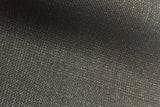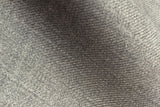Fine Fabrics, Proper Provenance
A great suit, like a great friend, is an investment of time and attention, that says a great deal about you, and will be with you for years. And like friends, suits should be chosen with care. You don't want to saddle yourself with a wingman who's also a con-man, and you definitely don't want a suit that isn't what it pretends to be.
What are we talking about? We're talking about authenticity, about ethics, about quality and, yes, about pedigree. Your friends can be as motley a crew as those sharing a university dorm, but you should always know with full confidence that your suit is a 100% purebred.
We could go on about Chinese fabric mills with elaborately fake Italian names and the like, but we'll stick with the basics today in our Suit Provenance 101 post, and give you some simple tips to ensure you're getting what you pay for and nothing less.
Check the Selvedge
This is the woven edge of the fabric which has the mill's name. Google it and see where the mill is actually located. If it's a European-sounding name but not located in Europe, that doesn't necessarily guarantee the fabric isn't wool, but you already know it isn't what it's pretending to be.
Look for the Label
True European fabrics will have a label (closely guarded) to be sewn into the suit. There is an active black market in these labels, so if something looks too good to be true, and it comes with a label, from a tailor you've never seen before, it probably IS too good to be true.
Get a Personal Recommendation
It's tempting, isn't it? Your first trip to Hong Kong or Bangkok, and it seems the streets are lined with tiny tailor shops, each with their imploring man out front, begging you to fondle their wool/cashmere blend and let them whip you up a natty suit in an impossible timeframe for what seems like an incredibly low price. Tempting indeed, but without a recommendation from someone who has actually bought and worn a suit from that particular shop, you're doing no more than making a wild bet that YOU will be the one foreigner to pick the best tailor, basically at random.
As the Tailor On Ten blog says:
Many Bangkok tailors claim they are selling a Wool/Cashmere blend when in reality they are stitching you up with Polyester. If you look around enough you will find the legitimate shops, chances are their sales pitch won’t be as forced and they definitely won’t have hawkers out the front. Oh and if you get a recommendation from a hotel concierge you are guaranteed to get plastic.
They recommend doing a burn test, ie actually burning a thread from the fabric to look for telltale signs of synthetics, if the tailor will let you perform it, but then, if you'd taken our advice and only asked someone you trust who's already been to the shop, it shouldn't be necessary.
Particularly if you've already seen him in one of their suits.
Ethics in Action
Part of what makes excellent fabrics costly is labour: in particular, labour standards which are above the indentured servitude or sweatshop practices which are common in low-quality, low-cost manufacturers. You know the difference between Walmart clothes and Holt Renfrew ones; part of the difference in price goes into taking care of the people who create them. From paying a living wage to safety standards to pensions, ethics in the fabric industry are a measure of how far we have come from the days of child labour and the like. We are proud to pay our workers a living wage and enable our suppliers to do the same; part of that care for others is shared with every suit we make for you.
Living History
Spinning and weaving are two of the most historic industries in the world. Every time you handle a beautiful, supple Harris Tweed, for instance, you are connected with generations of weavers from one unique place in Scotland. They are so justifiably proud of their work and their traditions that they have trademarked the term, and woe betide the counterfeiter who gets caught using it.
Contrast that with the sad situation in the African country of Ghana. In the '80's it had a robust fabric industry, employing in excess of 30,000 people: now it employs only one-tenth that. The culprit? Chinese copycats. "They don’t only copy our designs they copy the trademark and logo and label. Almost every design we make has been copied," said Kofi Boateng, managing director of one of the remaining fabric mills.
That's in direct contradiction to international treaties and industry trade groups, of course, but criminals count on slow-churning bureaucracy in China's wizz-bang economy to get in, make their money, and get out before they can be caught. With few foreign buyers willing to make the trek to remote industrial cities to inspect the mills themselves, shady businesses have only to present a respectable front and undercut the competition to make some quick sales.
The counterfeiting problem is so bad that China has produced counterfeit counterfeiting inspectors. Chinese counterfeiting costs legitimate businesses an estimated $20 billion a year in lost profits.
Fabric is the Foundation
Just as you wouldn't build a house on quicksand, neither should you pay for a suit out of fabric you have taken on faith. Check the provenance, check the quality, check the fiber with a burn test if you're feeling like a chemist (and the tailor obliges, dont' light things on fire in a fabric-filled shop if you haven't got permission) and check the reputation of the tailor. A suit is a partner; it will be with you for years, perhaps decades. You should know what you're getting into with a relationship like that!














